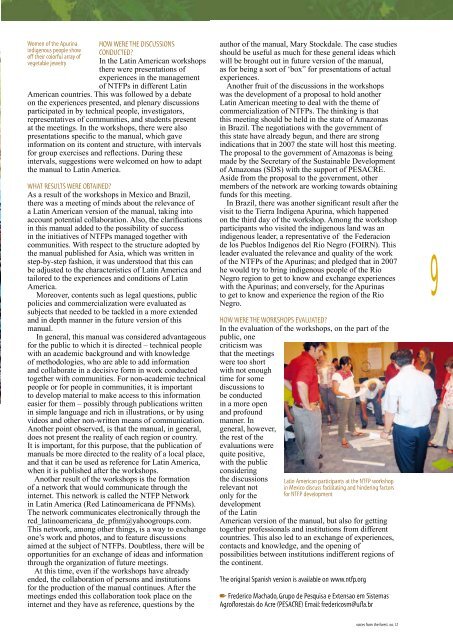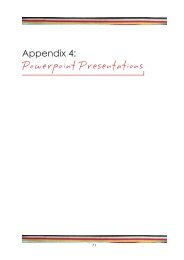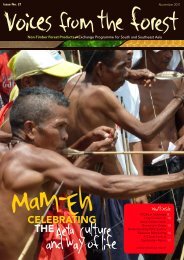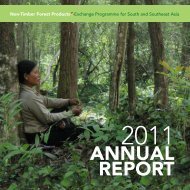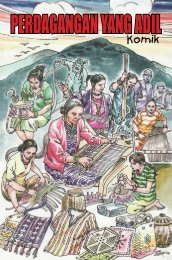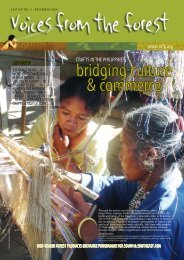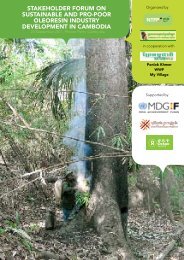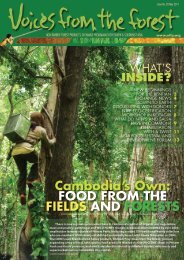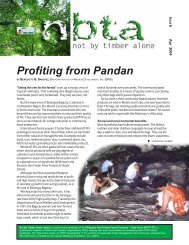Edition No. 12 - Non-Timber Forest Products Exchange Programme
Edition No. 12 - Non-Timber Forest Products Exchange Programme
Edition No. 12 - Non-Timber Forest Products Exchange Programme
Create successful ePaper yourself
Turn your PDF publications into a flip-book with our unique Google optimized e-Paper software.
Women of the Apurinaindigenous people showoff their colorful array ofvegetable jewelryHOW WERE THE DISCUSSIONSCONDUCTED?In the Latin American workshopsthere were presentations ofexperiences in the managementof NTFPs in different LatinAmerican countries. This was followed by a debateon the experiences presented, and plenary discussionsparticipated in by technical people, investigators,representatives of communities, and students presentat the meetings. In the workshops, there were alsopresentations specific to the manual, which gaveinformation on its content and structure, with intervalsfor group exercises and reflections. During theseintervals, suggestions were welcomed on how to adaptthe manual to Latin America.WHAT RESULTS WERE OBTAINED?As a result of the workshops in Mexico and Brazil,there was a meeting of minds about the relevance ofa Latin American version of the manual, taking intoaccount potential collaboration. Also, the clarificationsin this manual added to the possibility of successin the initiatives of NTFPs managed together withcommunities. With respect to the structure adopted bythe manual published for Asia, which was written instep-by-step fashion, it was understood that this canbe adjusted to the characteristics of Latin America andtailored to the experiences and conditions of LatinAmerica.Moreover, contents such as legal questions, publicpolicies and commercialization were evaluated assubjects that needed to be tackled in a more extendedand in depth manner in the future version of thismanual.In general, this manual was considered advantageousfor the public to which it is directed – technical peoplewith an academic background and with knowledgeof methodologies, who are able to add informationand collaborate in a decisive form in work conductedtogether with communities. For non-academic technicalpeople or for people in communities, it is importantto develop material to make access to this informationeasier for them – possibly through publications writtenin simple language and rich in illustrations, or by usingvideos and other non-written means of communication.Another point observed, is that the manual, in general,does not present the reality of each region or country.It is important, for this purpose, that the publication ofmanuals be more directed to the reality of a local place,and that it can be used as reference for Latin America,when it is published after the workshops.Another result of the workshops is the formationof a network that would communicate through theinternet. This network is called the NTFP Networkin Latin America (Red Latinoamericana de PFNMs).The network communicates electronically through thered_latinoamericana_de_pfnm@yahoogroups.com.This network, among other things, is a way to exchangeone’s work and photos, and to feature discussionsaimed at the subject of NTFPs. Doubtless, there will beopportunities for an exchange of ideas and informationthrough the organization of future meetings.At this time, even if the workshops have alreadyended, the collaboration of persons and institutionsfor the production of the manual continues. After themeetings ended this collaboration took place on theinternet and they have as reference, questions by theauthor of the manual, Mary Stockdale. The case studiesshould be useful as much for these general ideas whichwill be brought out in future version of the manual,as for being a sort of ‘box” for presentations of actualexperiences.Another fruit of the discussions in the workshopswas the development of a proposal to hold anotherLatin American meeting to deal with the theme ofcommercialization of NTFPs. The thinking is thatthis meeting should be held in the state of Amazonasin Brazil. The negotiations with the government ofthis state have already begun, and there are strongindications that in 2007 the state will host this meeting.The proposal to the government of Amazonas is beingmade by the Secretary of the Sustainable Developmentof Amazonas (SDS) with the support of PESACRE.Aside from the proposal to the government, othermembers of the network are working towards obtainingfunds for this meeting.In Brazil, there was another significant result after thevisit to the Tierra Indigena Apurina, which happenedon the third day of the workshop. Among the workshopparticipants who visited the indigenous land was anindigenous leader, a representative of the Federacionde los Pueblos Indigenos del Rio Negro (FOIRN). Thisleader evaluated the relevance and quality of the workof the NTFPs of the Apurinas; and pledged that in 2007he would try to bring indigenous people of the RioNegro region to get to know and exchange experienceswith the Apurinas; and conversely, for the Apurinasto get to know and experience the region of the RioNegro.HOW WERE THE WORKSHOPS EVALUATED?In the evaluation of the workshops, on the part of thepublic, onecriticism wasthat the meetingswere too shortwith not enoughtime for somediscussions tobe conductedin a more openand profoundmanner. Ingeneral, however,the rest of theevaluations werequite positive,with the publicconsideringthe discussionsrelevant notonly for thedevelopmentof the LatinLatin American participants at the NTFP workshopin Mexico discuss facilitating and hindering factorsfor NTFP developmentAmerican version of the manual, but also for gettingtogether professionals and institutions from differentcountries. This also led to an exchange of experiences,contacts and knowledge, and the opening ofpossibilities between institutions indifferent regions ofthe continent.The original Spanish version is available on www.ntfp.orgFrederico Machado, Grupo de Pesquisa e Extensao em SistemasAgroflorestais do Acre (PESACRE) Email: fredericosm@ufla.br9voices from the forest no. <strong>12</strong>


